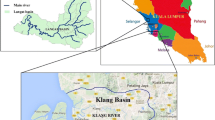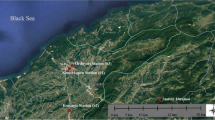Abstract
Heavy metal toxicity is a matter of considerable concern for environmental researchers. A highly cause of heavy metal toxicity in the aquatic environments is considered a serious issue that required full attention to understand in order to solve it. Heavy metal accumulation is a vital parameter for studying the water quality. Therefore, there is a need to develop an accurate prediction model for heavy metal accumulation. Recently, the artificial neural networks have been examined for similar prediction applications and showed great potential to tackle and detect its nonlinearity behavior. In this paper, radial basis function neural network algorithm has been utilized to investigate and mimic the relationship of heavy metals with the climatic and pollution conditions in lake water bodies. Thus, the present study was implemented in different climatic conditions (tropical “Malaysia” and arid “Libya”) as well as polluted and non-polluted lakes. Weekly records of physiochemical parameters data (e.g., pH, EC, WT, DO, TDS, TSS, CL, NO3, PO4 and SO4) and climatological parameters (e.g., air temperature, humidity and rainfall) were utilized as an input data for the modeling, whereas the heavy metal concentration was the output of the model. Three different scenarios for modeling the input architecture considering the climate, pollution or both have been investigated. In general, results obtained from all the scenarios are positively encouraging with high-performance accuracy. Furthermore, the results showed that an isolated model for each condition achieves a better prediction accuracy level rather than developing one general model for all conditions.












Similar content being viewed by others
References
Lawley R, Curtis L, Davis J (2012) The food safety hazard guidebook. Royal Society of Chemistry, London
Lide DR (1992) Handbook of chemistry & physics, 73rd edn. CRC Press, Boca Raton
Amoako J, Karikari A, Ansa-Asare O (2011) Physico-chemical quality of boreholes in Densu Basin of Ghana. Applied Water Science 1(1–2):41–48
Haiyan W, Stuanes AO (2003) Heavy metal pollution in air-water-soil-plant system of Zhuzhou City, Hunan Province, China. Water Air Soil Pollut 147(1–4):79–107
Hnaťuková P (2011) Geochemical distribution and mobility of heavy metals in sediments of urban streams affected by combined sewer overflows. Journal of Hydrology and Hydromechanics 59(2):85–94
Lee J, Chon H (2006) Hydrogeochemical characteristics of acid mine drainage in the vicinity of an abandoned mine, Daduk Creek. Korea. Journal of Geochemical Exploration 88(1):37–40
Odjer-Bio NT, Belford EJ, Ansong M (2015) What is happening to our Lagoons? The example of Butuah Lagoon in Ghana. International Journal of Energy and Environmental Engineering 6(2):183–193
Sim SF et al (2014) Distribution of major and trace elements in a tropical hydroelectric reservoir in Sarawak, Malaysia. International Scholarly Research Notices, 2014
Smuda J et al (2007) Mineralogical and geochemical study of element mobility at the sulfide-rich Excelsior waste rock dump from the polymetallic Zn–Pb–(Ag–Bi–Cu) deposit, Cerro de Pasco, Peru. J Geochem Explor 92(2):97–110
Wilson B, Lang B, Pyatt FB (2005) The dispersion of heavy metals in the vicinity of Britannia Mine, British Columbia. Canada. Ecotoxicology and Environmental Safety 60(3):269–276
Wogu MD, Okaka CE (2011) Pollution studies on Nigerian rivers: heavy metals in surface water of Warri river, Delta State. Journal of Biodiversity and Environmental Sciences 1(3):7–12
Kerketta P et al (2013) Analysis of physico-chemical properties and heavy metals in drinking water from different sources in and around Ranchi, Jharkhand. India. Analysis 6(7):370–375
Oluyemi E et al (2010) Physico-chemical properties and heavy metal content of water sources in Ife North Local Government Area of Osun State, Nigeria. African Journal of Environmental Science and Technology 4(10):691–697
Singh AP, Srivastava PC, Srivastava P (2008) Relationships of heavy metals in natural lake waters with physico-chemical characteristics of waters and different chemical fractions of metals in sediments. Water Air Soil Pollut 188(1–4):181–193
Rooki R et al (2011) Prediction of heavy metals in acid mine drainage using artificial neural network from the Shur River of the Sarcheshmeh porphyry copper mine. Southeast Iran. Environmental Earth Sciences 64(5):1303–1316
Govindaraju RS (2000) Artificial neural networks in hydrology. I: preliminary concepts. J Hydrol Eng 5(2):115–123
Yaseen ZM et al (2015) Artificial intelligence based models for stream-flow forecasting: 2000–2015. J Hydrol 530:829–844
Yaseen ZM et al (2015) RBFNN versus FFNN for daily river flow forecasting at Johor River. Malaysia, Neural Computing and Applications
Wetzel RG ((2001)) Limnology: lake and river ecosystems, vol 37, pp 1006–1006
Najah A et al (2009) Prediction of Johor River water quality parameters using artificial neural networks. Eur J Sci Res 28(3):422–435
Najah A et al (2011) An application of different artificial intelligences techniques for water quality prediction. Int J Phys Sci 6(22):5298–5308
Ma L, Xin K, Liu S (2008) Using radial basis function neural networks to calibrate water quality model. Int J Electr Comput Eng 3:6
Lin G-F, Chen L-H (2004) A non-linear rainfall-runoff model using radial basis function network. J Hydrol 289(1–4):1–8
El-Shafie A et al (2008) Enhancing Inflow Forecasting Model at Aswan High Dam Utilizing Radial Basis Neural Network and Upstream Monitoring Stations Measurements. Water Resour Manage 23(11):2289–2315
Beckert A, Wendland H (2001) Multivariate interpolation for fluid-structure-interaction problems using radial basis functions. Aerosp Sci Technol 5(2):125–134
Afan HA et al (2015) ANN based sediment prediction model utilizing different input scenarios. Water Resour Manage 29(4):1231–1245
Lowe D, Broomhead D (1988) Multivariable functional interpolation and adaptive networks. Complex systems 2:321–355
Bishop CM (1995) Neural networks for pattern recognition, vol 92, pp 482–482
Ripley BD (1996) Pattern recognition and neural networks. Cambridge University Press, Cambridge, p 403
Simon H (1999) Neural networks: a comprehensive foundation. Prentice Hall, Upper Saddle River, p 842
Moradkhani H et al (2004) Improved streamflow forecasting using self-organizing radial basis function artificial neural networks 1:246–262
Prasad MNV (2013) Heavy metal stress in plants: from biomolecules to ecosystems. Springer, New York
Iqbal PJ, Pandit AK, Javed JA (2006) Impact of sewage waste from human settlements on the physico-chemical characteristics of Dal lake, Kashmir. J Res Dev 6:81–85
Miskimmin BM, Rudd JW, Kelly CA (1992) Influence of dissolved organic carbon, pH, and microbial respiration rates on mercury methylation and demethylation in lake water. Can J Fish Aquat Sci 49(1):17–22
El Shakour EHA, Mostafa A (2012) Water quality assessment of river Nile at Rosetta branch: impact of drains discharge. Middle-East J Sci Res 12(4):413–423
Momba MNB et al (2006) Safe drinking water still a dream in rural areas of South Africa. Case study: The Eastern Cape Province. Water SA. 32(5 SPEC. ISS):715–720
Sonzogni WC et al (1980) Pollution from land runoff. Environ Sci Technol 14(2):148–153
Charkhabi A, Sakizadeh M (2006) Assessment of spatial variation of water quality parameters in the most polluted branch of the Anzali wetland, Northern Iran. Polish Journal of Environmental Studies 15(3):395–403
Acknowledgments
The authors appreciate so much the financial support received by the second author via DIP-2012-03 project funded from Universiti Kebangsaan Malaysia.
Author information
Authors and Affiliations
Corresponding author
Rights and permissions
About this article
Cite this article
Elzwayie, A., El-shafie, A., Yaseen, Z.M. et al. RBFNN-based model for heavy metal prediction for different climatic and pollution conditions. Neural Comput & Applic 28, 1991–2003 (2017). https://doi.org/10.1007/s00521-015-2174-7
Received:
Accepted:
Published:
Issue Date:
DOI: https://doi.org/10.1007/s00521-015-2174-7




